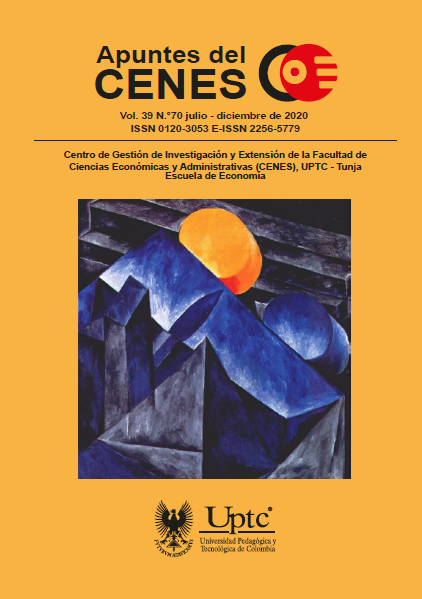Determinantes de los flujos comerciales entre Colombia y Corea del Sur

Resumen
Este trabajo de investigación identifica los determinantes de los flujos comerciales entre Colombia y Corea del Sur. Para ello, se analiza el perfil comercial de ambos países, el comercio bilateral y el TLC firmado. Así mismo, se aplica un modelo gravitacional para el comercio total y sectorial con datos de panel para el período 1993-2013, encontrando consistencia con los postulados teóricos. De manera que variables como los ingresos de los países importadores y exportadores determinan el comercio bilateral positivo y significativo, mientras que la distancia y el litoral disminuyen la probabilidad de comercio. Además, los resultados del modelo gravitacional indican que los acuerdos de libre comercio no tienen un efecto significativo en el comercio de Corea del Sur de acuerdo con la estimación realizada; sin embargo, del análisis del acuerdo se considera que los productos agrícolas y agroindustriales colombianos tienen oportunidades potenciales para competir en el país asiático.
Palabras clave
Comercio bilateral; modelo gravitacional; tratado de libre comercio; Corea del Sur; Colombia;
Referencias
1. Anaman, K. & Al-Kharusi, L. (2003). An Analysis of Trade Flows between Brunei Darussalam and the European Union. ASEAN Economic Bulletin, 20, 60-72. https://doi.org/10.1355/AE20-1E
2. Anderson, J. & Van Wincoop, E. (2003). Gravity with Gravitas: A Solution to the Border Puzzle. The American Economic Review, 93, 170-192. https://doi.org/10.1257/000282803321455214
3. Bergstrand, J. (1985). The Gravity Equation in International Trade: Some Microeconomic Foundations and Empirical Evidence. The Review of Economics and Statistics, 67, 474-481. https://doi.org/10.2307/1925976
4. Bergstrand, J. (1989). The generalized gravity equation, monopolistic competition, and the factor-proportions theory in international trade. The Review of Economics and Statistics, 71, 143-153. https://doi.org/10.2307/1928061
5. Centro de Investigaciones para el Desarrollo (CID). (2007). Impacto del TLC en el departamento de Cundinamarca. CID.
6. Congreso de la República de Colombia. (2014, 26 de dic.). Ley 174 de 2012. Por medio de la cual se aprueba el Acuerdo de libre comercio entre la República de Colombia y la República de Corea. http://www.tlc.gov.co/publicaciones/733/acuerdode_libre_comercio_entre_la_republica_de_colombia_y_la_republica_de_corea
7. Deardorff, A. (1998). Determinants of Bilateral Trade: Does Gravity Work in a Neoclassical World? National Bureau of Economic Research, 7-32.
8. Dixit, A. (1989). Entry and Exit Decisions under Uncertainty. Journal of Political Economy, 97620-638. https://doi.org/10.1086/261619
9. Evenett, S. & Keller, W. (2002). On Theories Explaining the Success of the Gravity Equation. Journal of Political Economy, 110, 281-316. https://doi.org/10.1086/338746
10. Hellvin, L. & Nilsson, L. (2000). Trade Flows between Trading Blocs: The Case of the EU's Trade with Asia and NAFTA. Discussion Paper.
11. Helpman, E. & Krugman, P. (1985). Market Structure and Foreign Trade: Increasing Returns, Imperfect Competition and the International Economy. The MIT Press.
12. Helpman, E., Melitz, M. & Rubinstein, Y. (2008). Estimating Trade Flows: Trading Partners and Trading Volumes. Quarterly Journal of Economics, 123441-487. https://doi.org/10.1162/qjec.2008.123.2.441
13. Krugman, P. (1980). Scale Economies, Product Differentiation and the Pattern of Trade. American Economic Association, 70, 950-959.
14. Krugman, P. (1981). Intraindustry Specialization and the Gains From Trade. The Journal of Political Economy, 89, 959-973. https://doi.org/10.1086/261015
15. Krugman, P. (1983). New Theories of Trade among Industrial Countries. The American Economic Review, 73, 343-347.
16. Krugman, P. & Obstfeld, M. (2005). Economía internacional. Teoría y política. Pearson Educación.
17. Melitz, M. (2003). The Impact of Trade on Intra-Industry Reallocations and Aggregate Industry Productivity. Econometrica, 71, 1695-1725. https://doi.org/10.1111/1468-0262.00467
18. Ministerio de Comercio, Industria y Turismo. (2010). Corea del Sur: dinámica comercial y relaciones bilaterales con Colombia. Documentos OEE-04. Oficina de Estudios Económicos.
19. Ministerio de Comercio, Industria y Turismo. (2013a). 100 preguntas del TLC con Corea. http://www.mincit.gov.co/publicaciones.php?id=3292&dPrint=1
20. Ministerio de Comercio, Industria y Turismo. (2013b). Acuerdo de Libre Comercio entre la República de Colombia y la República de Corea. http://www.tlc.gov.co/publicaciones.php?id=733
21. Reina, M., Salamanca, C. & Forero, D. (2009). Factibilidad de un Tratado de Libre Comercio entre Colombia y la República de Corea. Working Paper 49. Fedesarrollo,
22. Tinbergen, J. (1962). Shaping the World Economy; Suggestions for an International Economic Policy. Twenty Century Fund.
